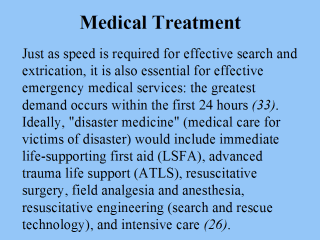 |
Unconscious
patients with either upper airway obstruction or inhalation injury or any
patients with correctable hypovolemia resulting from hemorrhage or burns
would be especially likely to benefit from early medical intervention.
Safar, studying the 1980 earthquake in Italy, concluded that 25% to 50% of
victims who were injured and died slowly could have been saved if
life-saving first aid had been rendered immediately (114). Data
from the 1976 earthquake in Guatemala (115,116), the 1985 Mexico City
earthquake (29), the 1988 Armenian earthquake (33), and the
1992 earthquake in Egypt (86) showed that injured people usually seek
emergency medical attention only during the first 3 to 5 days following the
earthquake, after which hospital case-mix patterns return almost to normal.
From Day 6 onward, the need for emergency medical attention declined rapidly
and the majority of the wounded required only ambulatory medical
attention--indicating that specialized field hospitals that arrive 1 week or
more after an earthquake are generally too late to help during the emergency
phase. Following the 1992 earthquake in Egypt, nearly 70% of all patients
with earthquake-related injuries were admitted within the first 36 hours
after this earthquake (86). |
